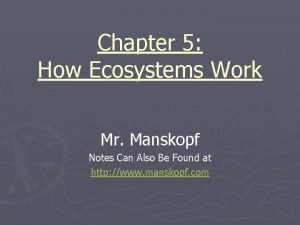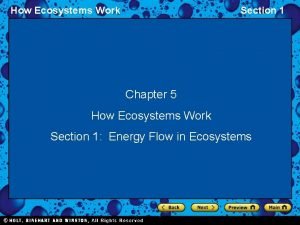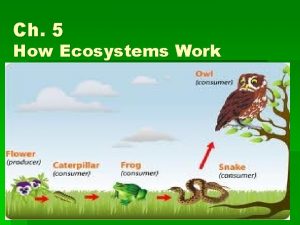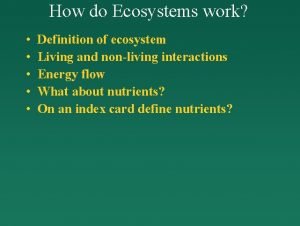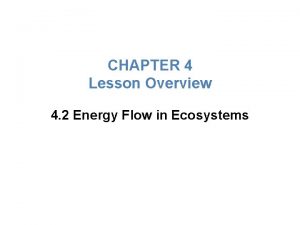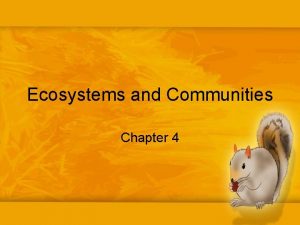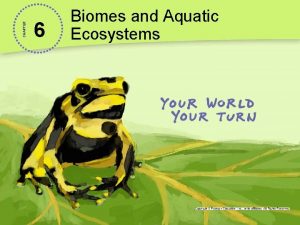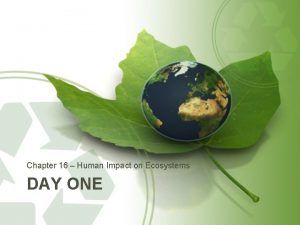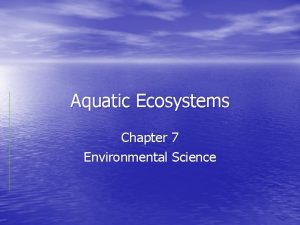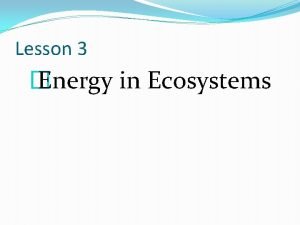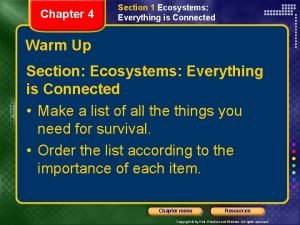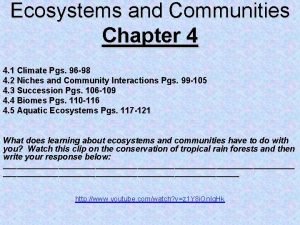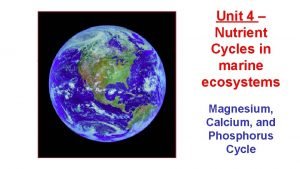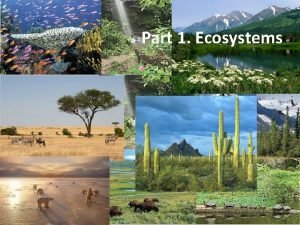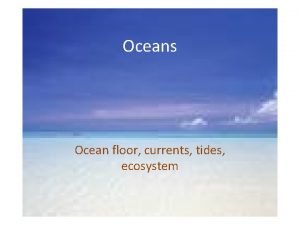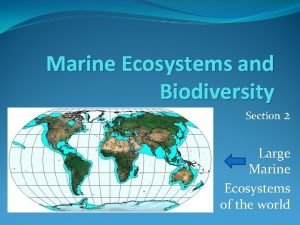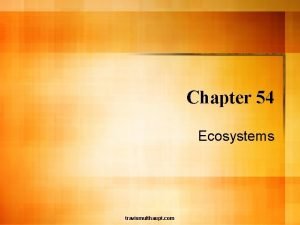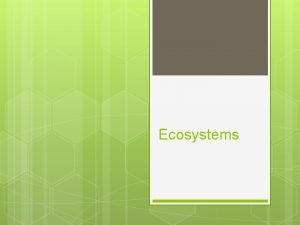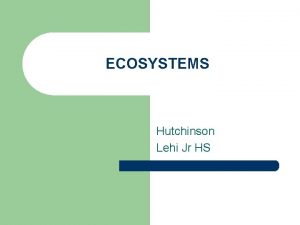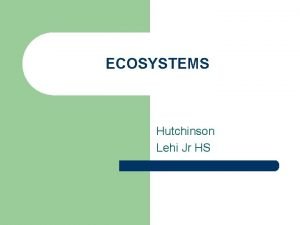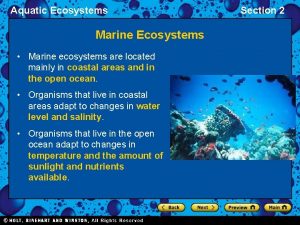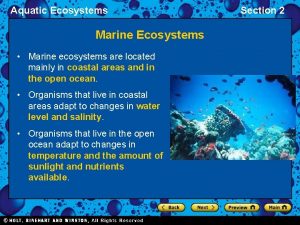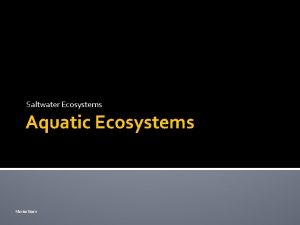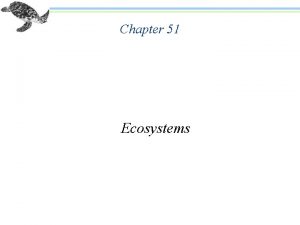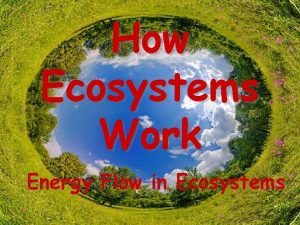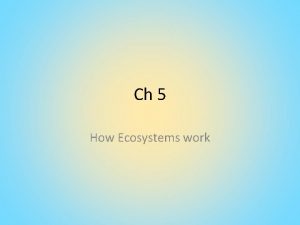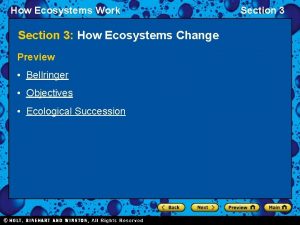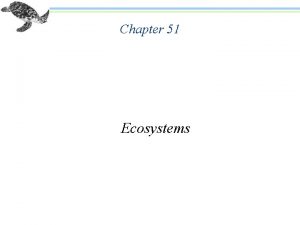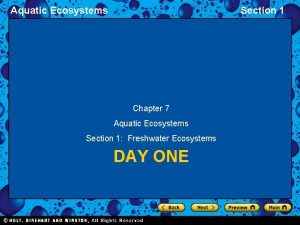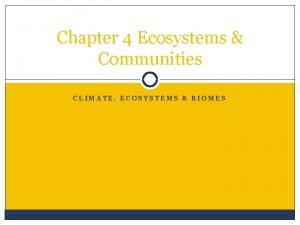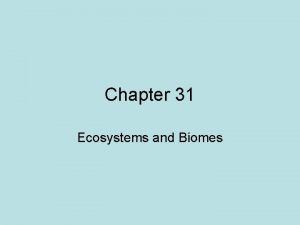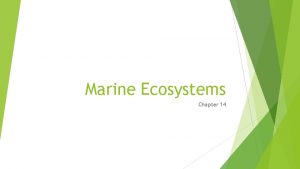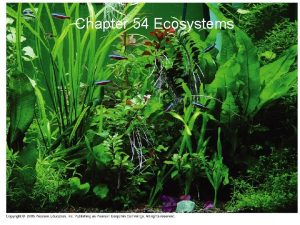How Ecosystems Work CHAPTER 5 HOW ECOSYSTEMS WORK





























- Slides: 29

How Ecosystems Work CHAPTER 5 HOW ECOSYSTEMS WORK SECTION 1 ENERGY FLOW IN ECOSYSTEMS Section 1

How Ecosystems Work Life Depends on the Sun • Energy from the sun enters an ecosystem when plants use sunlight to make sugar molecules. • This happens through a process called photosynthesis. Section 1

How Ecosystems Work Section 1 Life Depends on the Sun • Photosynthesis is the process by which plants, algae, and some bacteria use sunlight, carbon dioxide, and water to produce carbohydrates and oxygen. • End result of photosynthesis is a carbohydrate (a sugar molecule called glucose). • Gives you energy to do daily activities.

How Ecosystems Work Section 1

How Ecosystems Work Photosynthesis Section 1

How Ecosystems Work From Producers to Consumers • Because plants make their own food, they are called producers. • A producer is an organism that can make organic molecules from inorganic molecules. • Producers are also called autotrophs, or self-feeders. Section 1

How Ecosystems Work From Producers to Consumers • Organisms that get their energy by eating other organisms are called consumers. • A consumer is an organism that eats other organisms or organic matter instead of producing its own nutrients or obtaining nutrients from inorganic sources. • Consumers are also called heterotrophs, or other-feeders. Section 1

How Ecosystems Work Section 1 From Producers to Consumers • When a rabbit eats a clover plant, the rabbit gets energy from the carbohydrates the clover plant made through photosynthesis. • If a coyote eats the rabbit, some of the energy is transferred from the rabbit to the coyote. • In the example shown in above, the clover is the producer, and the rabbit and coyote are consumers.

How Ecosystems Work Section 1 From Producers to Consumers • Most producers get their energy directly from the sun by absorbing it through their leaves during photosynthesis. • Consumers get their energy indirectly by eating producers or other consumers.

How Ecosystems Work An Exception to the Rule • Deep-ocean communities of worms, clams, crabs, mussels, and barnacles, exist in total darkness on the ocean floor, where photosynthesis cannot occur. • The producers in this environment are bacteria that use hydrogen sulfide present in the water to create their food, in a process called chemosynthesis • Other underwater organisms eat the bacteria or the organisms that eat the bacteria. - creating entire food webs that NEVER SEE the SUN Section 1

How Ecosystems Work What Eats What? • Organisms can be classified by what they eat. • Types of Consumers: • Herbivores – eat only plants • Carnivores – eat only animals • Omnivores – eat both plants and animals • Decomposers – eat dead organic matter Section 1

How Ecosystems Work What Eats What? • Consumers that eat producers to get energy are what we call primary consumers. • In other words they are herbivores. • Most of the energy will be used up by the consumer (herbivore). • A consumer that eats another consumer is called a secondary consumer. Section 1

How Ecosystems Work What Eats What? Section 1

How Ecosystems Work Section 1 Something to help you remember! Energy Roles Song

How Ecosystems Work Section 1 Burning the Fuel • An organism obtains energy from the food it eats. • This food must be broken down within its body. • The process of breaking down food to yield energy is called cellular respiration.

How Ecosystems Work Burning the Fuel • Cellular respiration is the process by which cells produce energy from carbohydrates • Atmospheric oxygen combines with glucose to form water and carbon dioxide, releasing energy in the process. • Cellular respiration occurs inside the mitochondria of cells in most organisms. Section 1

How Ecosystems Work Section 1 Burning the Fuel • During cellular respiration, cells absorb oxygen and use it to release energy from food. • Through cellular respiration, cells use glucose (sugar) and oxygen to produce carbon dioxide, water, and energy.

How Ecosystems Work Section 1 Burning the Fuel • Part of the energy obtained through cellular respiration is used to carry out daily activities. • Every time you walk, breathe, read a book, think, or play a sport, you use energy. • The energy you obtain is also used to make more body tissues and to fight diseases so that you grow and stay healthy. • Excess energy is stored as sugar or fat.

How Ecosystems Work Plants do Cellular Respiration, too • All living things use cellular respiration to get the energy they need from food molecules. • Even organisms that make their own food through photosynthesis use cellular respiration to obtain energy from the carbohydrates they produce Section 1

How Ecosystems Work Section 1 Energy Transfer • Each time an organism eats another organism, an energy transfer occurs. • This transfer of energy can be traced by studying food chains, food webs, and trophic levels. • Studying the paths of energy between organisms can also tell us which organisms in an ecosystem depend on which other organisms to survive.

How Ecosystems Work Food Chains • A food chain is a sequence in which energy is transferred from one organism to the next as each organism eats another organism. • This Diagram shows a typical food chain in an ocean ecosystem. • Algae are eaten by krill, which are eaten by cod. • The cod are eaten by leopard seals, which are eaten by killer whales. Section 1

How Ecosystems Work • Ecosystems, however, usually contain more than one food chain. Food Webs • And each organism can eat more than one type of food • A food web shows many feeding relationships that are possible in an ecosystem. Section 1

How Ecosystems Work Trophic Levels • Each step in the transfer of energy through a food chain or food web is known as a trophic level. • A trophic level is one of the steps in a food chain or food pyramid; examples include producers and primary, secondary, and tertiary consumers. Section 1

How Ecosystems Work Trophic Levels • Each time energy is transferred, some of the energy is lost as heat. • Therefore, less energy is available to organisms at higher trophic levels. • Some of this energy is lost during cellular respiration. • Organisms use much of the remaining energy to carry out the functions of living, such as producing new cells, regulating body temperature, and moving around. • One way to visualize this is with an energy pyramid. Section 1

How Ecosystems Work Section 1 Energy Pyramids • Each layer in the energy pyramid represents one trophic level. • Producers form the base of the pyramid, the lowest trophic level, which contains the most energy. • Herbivores contain less energy and make up the second level. • Carnivores that feed on herbivores form the next level, and carnivores that feed on other carnivores make up the top level. • Organisms in the upper trophic levels store less energy than both herbivores and producers. • A pyramid is a good way to illustrate trophic levels because the pyramid becomes smaller toward the top, where less energy is available.

How Ecosystems Work Section 1 Energy Pyramids “Rule of 10” • About 90 percent of the energy at each trophic level is used up carrying out life’s processes. • The remaining 10 percent of the energy becomes part of the organism’s body as meat, muscles and organs and tissues and is stored in its molecules. • This 10 percent that is stored is all that is available to the next trophic level when one organism consumes (eats) another organism.

How Ecosystems Work Energy Loss Affects Ecosystems • Decreasing amounts of energy at each trophic level affects the organization of an ecosystem. • 1 st Energy loss affects the number of organisms at each level. • For example, zebras and other herbivores out number lions on the African savanna by about 1, 000 to 1 Section 1

How Ecosystems Work Section 1 How Energy Loss Affects an Ecosystem • 2 nd Energy loss limits the number of trophic levels in an ecosystem. • Ecosystems rarely have more than four or five trophic levels because the ecosystem does not have enough energy left to support higher levels. • For example, a lion typically needs up to 250 km 2 of land to hunt for food. • Therefore, an animal that feeds on lions would have to expend a lot of energy to harvest the small amount of energy available at the top trophic level. • The organisms that do feed on organisms at the top trophic level are usually small, such as parasitic worms and fleas that require a very small amount of energy.

How Ecosystems Work Section 1 5: 1 Energy Flow in Ecosystems Main Ideas • The majority of the Earth’s organisms depend on the sun for energy. Producers harness the sun’s energy directly through photosynthesis, while consumers use the sun’s energy indirectly by eating producers or other consumers. • The paths of energy transfer can be followed through food chains, food webs, and trophic levels. • Only about 10 percent of the energy that an organism consumes is stored and transferred when that organism is eaten.
 Chapter 5 how ecosystems work study guide
Chapter 5 how ecosystems work study guide How ecosystems work
How ecosystems work How ecosystems work
How ecosystems work How do ecosystems work
How do ecosystems work Chapter 3 section 3 aquatic ecosystems
Chapter 3 section 3 aquatic ecosystems Chapter 4 lesson 2 energy flow in ecosystems
Chapter 4 lesson 2 energy flow in ecosystems Chapter 4 ecosystems and communities vocabulary review
Chapter 4 ecosystems and communities vocabulary review Chapter 6 biomes and aquatic ecosystems
Chapter 6 biomes and aquatic ecosystems 3 aquatic biomes
3 aquatic biomes Phosphorus cycle pearson education
Phosphorus cycle pearson education Chapter 42 ecosystems and energy
Chapter 42 ecosystems and energy Chapter 3 lesson 3 biomes and aquatic ecosystems
Chapter 3 lesson 3 biomes and aquatic ecosystems Chapter 16 human impact on ecosystems
Chapter 16 human impact on ecosystems Chapter 7 environmental science
Chapter 7 environmental science Which marine ecosystem contains the fewest producers
Which marine ecosystem contains the fewest producers Chapter 7 aquatic ecosystems test answers
Chapter 7 aquatic ecosystems test answers Chapter 16 human impact on ecosystems
Chapter 16 human impact on ecosystems Chapter 55 ecosystems and restoration ecology
Chapter 55 ecosystems and restoration ecology Section ecosystems everything is connected
Section ecosystems everything is connected Unit 5 ecology
Unit 5 ecology Parasitism examples
Parasitism examples Chapter 4 section 1 work and machines answer key
Chapter 4 section 1 work and machines answer key Pollution effects on ecosystems
Pollution effects on ecosystems Biological use of magnesium in marine ecosystems
Biological use of magnesium in marine ecosystems Lesson outline lesson 2 aquatic ecosystems answer key
Lesson outline lesson 2 aquatic ecosystems answer key Ecosystems examples
Ecosystems examples The ecosystems
The ecosystems Aquatic food chain
Aquatic food chain Biodiversity
Biodiversity Interactions in the environment grade 7
Interactions in the environment grade 7
